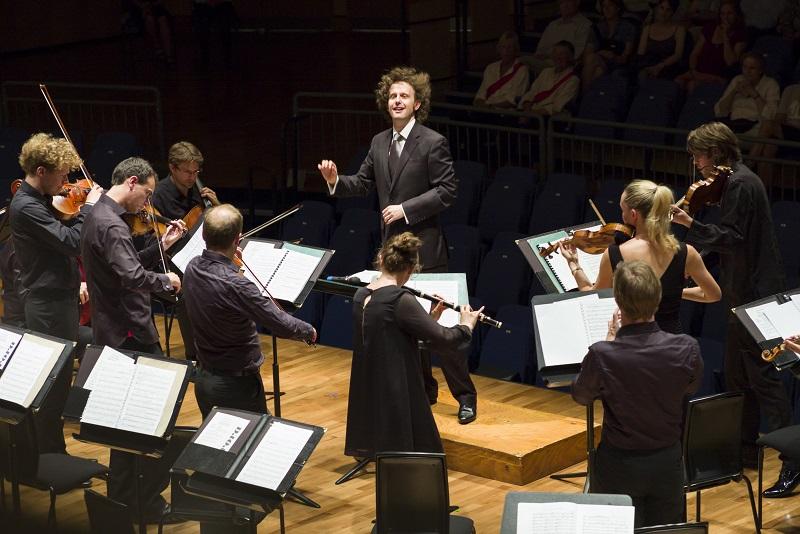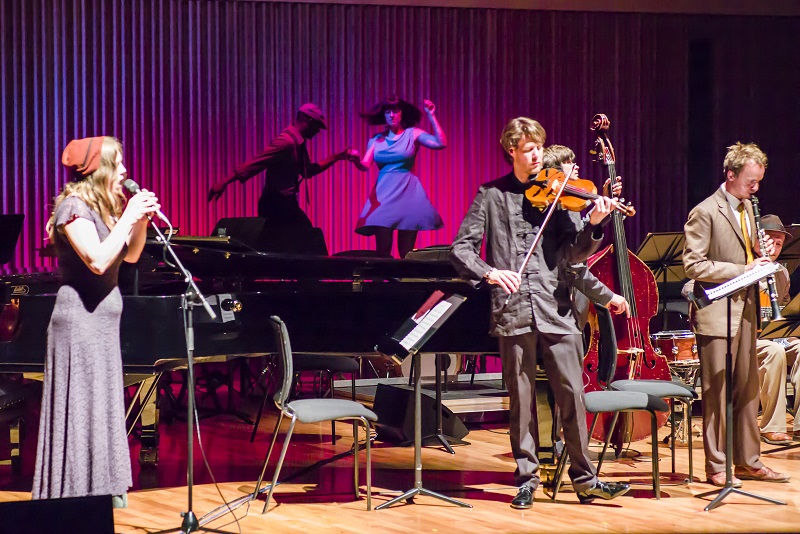Man Overboard, Aurora Orchestra, Collon, LSO St Luke's | reviews, news & interviews
Man Overboard, Aurora Orchestra, Collon, LSO St Luke's
Man Overboard, Aurora Orchestra, Collon, LSO St Luke's
London's cross-collaborating ensemble wears its USP on its sleeve

If the 15-word limit of a succinct listings blurb ever taught you a lesson let it be immediate suspicion of any performer or musician termed "jazzy". This wariness could extend to anything generically suffixed by "y" or "ish", simply because it suggests either pretence or a lack of original or strong identity.
From conductor Nicholas Collon's swift and jovial entrance onto the stage at LSO St Luke's, to the players' flamboyant swaying, the Aurora Orchestra are quite clearly a well-staged entity. Their slick showmanship, low necklines and less traditional choices of collaborators provide that crucial USP that the LPO, RPO, LSO or other acronym-bound ensembles might also consider at an audience development meeting.
Rameau was the first to be tackled in this Jitterbug-themed show, and was played with a certain gusto, modelled perhaps on the mesmerising energy of Italy's L'Aura Soave Cremona ensemble, albeit with a sheen of British modesty. Charming though its rhythmic bounce, baroque can be a tiresome affair of predictable cycles and musical ringlets, but thankfully they had anticipated a modern attention span. Following only a moment's pause their top-heavy ornamental sound broke down into a bold solo double bass line that seemed both out of place and almost credible as a radical final scherzo. It is these musical hinges that characterise the Aurora Orchestra's work, and their commitment to re-contextualising classical repertoire is welcome.
 Building now from the rhythm section and upwards via viola and harpsichord, to be joined on stage by trilby-clad "gypsy jazz"-style guitarist Jean-Marie Fagon and crew, it was clear we had apparently travelled forward a few centuries and descended into the cellar of a European wine bar. Man Overboard were to become the second feature of a transatlantic foray into the historical dance music repertoire. True to the event flyer, but somewhat incongruously, a couple of dancers from Swing Patrol floated onto a red-lit stage to accompany an arrangement of traditional standard "St James Infirmary" arranged by bassist Dave O'Brien. Meanwhile vocalist Louisa Jones clutched timidly at the microphone, retelling an age-old tale with her own subtle backstory and a tone authentically reminiscent of a husky, melancholic blues songstress.
Building now from the rhythm section and upwards via viola and harpsichord, to be joined on stage by trilby-clad "gypsy jazz"-style guitarist Jean-Marie Fagon and crew, it was clear we had apparently travelled forward a few centuries and descended into the cellar of a European wine bar. Man Overboard were to become the second feature of a transatlantic foray into the historical dance music repertoire. True to the event flyer, but somewhat incongruously, a couple of dancers from Swing Patrol floated onto a red-lit stage to accompany an arrangement of traditional standard "St James Infirmary" arranged by bassist Dave O'Brien. Meanwhile vocalist Louisa Jones clutched timidly at the microphone, retelling an age-old tale with her own subtle backstory and a tone authentically reminiscent of a husky, melancholic blues songstress.
Creative though their approach is, the missing element of the concert was something ephemeral. Nowadays we might call it groove, but for the era in question "swing" is the fad-word and, however pretty the typeface on the programme, without that indefinable crux of dance music it don't really mean a thing. The final piece, before the auditorium was transformed into a "Speakeasy" dancehall, was a rare modern arrangement of "Porgy and Bess", starring an amusingly understaffed percussion department of only one manic marimba and timpanist. Gershwin, who himself was evoking jazz, was a fitting crowd-pleaser to conclude a concert which hinted at atmospheres and themes, but was a little too "-ish" to move much more than the big toe in a distant leather sandal.
rating
Explore topics
Share this article
Add comment
The future of Arts Journalism
You can stop theartsdesk.com closing!
We urgently need financing to survive. Our fundraising drive has thus far raised £49,000 but we need to reach £100,000 or we will be forced to close. Please contribute here: https://gofund.me/c3f6033d
And if you can forward this information to anyone who might assist, we’d be grateful.

Subscribe to theartsdesk.com
Thank you for continuing to read our work on theartsdesk.com. For unlimited access to every article in its entirety, including our archive of more than 15,000 pieces, we're asking for £5 per month or £40 per year. We feel it's a very good deal, and hope you do too.
To take a subscription now simply click here.
And if you're looking for that extra gift for a friend or family member, why not treat them to a theartsdesk.com gift subscription?
more Classical music
 BBC Proms: Barruk, Norwegian Chamber Orchestra, Kuusisto review - vague incantations, precise laments
First-half mix of Sámi songs and string things falters, but Shostakovich scours the soul
BBC Proms: Barruk, Norwegian Chamber Orchestra, Kuusisto review - vague incantations, precise laments
First-half mix of Sámi songs and string things falters, but Shostakovich scours the soul
 BBC Proms: Alexander’s Feast, Irish Baroque Orchestra, Whelan review - rapturous Handel fills the space
Pure joy, with a touch of introspection, from a great ensemble and three superb soloists
BBC Proms: Alexander’s Feast, Irish Baroque Orchestra, Whelan review - rapturous Handel fills the space
Pure joy, with a touch of introspection, from a great ensemble and three superb soloists
 BBC Proms: Moore, LSO, Bancroft review - the freshness of morning wind and brass
English concert band music...and an outlier
BBC Proms: Moore, LSO, Bancroft review - the freshness of morning wind and brass
English concert band music...and an outlier
 Willis-Sørensen, Ukrainian Freedom Orchestra, Wilson, Cadogan Hall review - romantic resilience
Passion, and polish, from Kyiv's musical warriors
Willis-Sørensen, Ukrainian Freedom Orchestra, Wilson, Cadogan Hall review - romantic resilience
Passion, and polish, from Kyiv's musical warriors
 BBC Proms: Faust, Gewandhausorchester Leipzig, Nelsons review - grace, then grandeur
A great fiddler lightens a dense orchestral palette
BBC Proms: Faust, Gewandhausorchester Leipzig, Nelsons review - grace, then grandeur
A great fiddler lightens a dense orchestral palette
 BBC Proms: Jansen, Royal Concertgebouw Orchestra, Mäkelä review - confirming a phenomenon
Second Prom of a great orchestra and chief conductor in waiting never puts a foot wrong
BBC Proms: Jansen, Royal Concertgebouw Orchestra, Mäkelä review - confirming a phenomenon
Second Prom of a great orchestra and chief conductor in waiting never puts a foot wrong
 BBC Proms: Royal Concertgebouw Orchestra, Mäkelä review - defiantly introverted Mahler 5 gives food for thought
Chief Conductor in Waiting has supple, nuanced chemistry with a great orchestra
BBC Proms: Royal Concertgebouw Orchestra, Mäkelä review - defiantly introverted Mahler 5 gives food for thought
Chief Conductor in Waiting has supple, nuanced chemistry with a great orchestra
 Dunedin Consort, Butt / D’Angelo, Muñoz, Edinburgh International Festival 2025 review - tedious Handel, directionless song recital
Ho-hum 'comic' cantata, and a song recital needing more than a beautiful voice
Dunedin Consort, Butt / D’Angelo, Muñoz, Edinburgh International Festival 2025 review - tedious Handel, directionless song recital
Ho-hum 'comic' cantata, and a song recital needing more than a beautiful voice
 Classical CDs: Dungeons, microtones and psychic distress
This year's big anniversary celebrated with a pair of boxes, plus clarinets, pianos and sacred music
Classical CDs: Dungeons, microtones and psychic distress
This year's big anniversary celebrated with a pair of boxes, plus clarinets, pianos and sacred music
 BBC Proms: Liu, Philharmonia, Rouvali review - fine-tuned Tchaikovsky epic
Sounds perfectly finessed in a colourful cornucopia
BBC Proms: Liu, Philharmonia, Rouvali review - fine-tuned Tchaikovsky epic
Sounds perfectly finessed in a colourful cornucopia
 BBC Proms: Suor Angelica, LSO, Pappano review - earthly passion, heavenly grief
A Sister to remember blesses Puccini's convent tragedy
BBC Proms: Suor Angelica, LSO, Pappano review - earthly passion, heavenly grief
A Sister to remember blesses Puccini's convent tragedy
 BBC Proms: A Mass of Life, BBCSO, Elder review - a subtle guide to Delius's Nietzschean masterpiece
Mark Elder held back from blasting the audience with a wall of sound
BBC Proms: A Mass of Life, BBCSO, Elder review - a subtle guide to Delius's Nietzschean masterpiece
Mark Elder held back from blasting the audience with a wall of sound

Comments
Interesting perspective. For